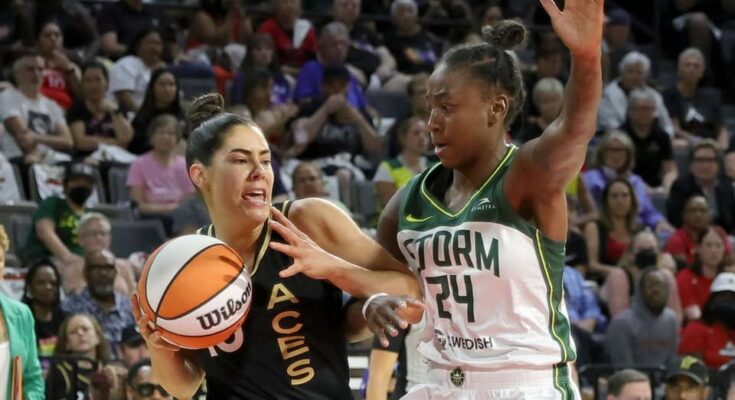The 2025 WNBA free agency period, which officially began with teams being able to make qualifying offers and core designations from January 11-20, and then negotiate with free agents starting January 21, proved to be a pivotal time for many franchises. With the new collective bargaining agreement (CBA) still in flux, many players opted for one-year deals to hit the market again soon, creating a dynamic and highly competitive free agency landscape.
The Core Designation remains one of the most powerful tools a WNBA team possesses. It allows a team to designate one of its unrestricted free agents as a “core” player, granting them exclusive negotiating rights. A player who receives a core designation is automatically offered a one-year, super-max contract. While the player can negotiate different terms, they cannot directly sign with another team unless their current team agrees to a sign-and-trade. A player can be “cored” a maximum of three times in their career. This rule aims to help teams, especially smaller markets, retain their star talent, though it often limits player autonomy.
Here are the top picks for the ten most sought-after 2025 WNBA free agents, including the six who were given the core designation, understanding what that means for their immediate future:
- Breanna Stewart (Forward – New York Liberty): Stewart, a two-time WNBA MVP and one of the most dominant players in the league, was undoubtedly the top priority for the reigning WNBA Champion New York Liberty. The Liberty did not hesitate to place the core designation on her. This means Stewart could only negotiate with the Liberty, ensuring she would remain in Brooklyn unless a sign-and-trade was mutually agreed upon. Given her expressed desire to stay and continue building a dynasty with the Liberty, her core designation was a formality that secured her return on a super-max deal, or a longer-term contract negotiated thereafter. She is committed to Brooklyn.
- Alyssa Thomas (Forward – Connecticut Sun): Thomas, a perennial MVP candidate known for her unmatched versatility, triple-double prowess, and defensive intensity, was a no-brainer to receive the core designation from the Connecticut Sun. She has been the heart and soul of the Sun, and her ability to impact every facet of the game makes her indispensable. The core designation meant Connecticut had exclusive rights to negotiate with her. While there was speculation about her future, she ultimately signed with the Phoenix Mercury, indicating a sign-and-trade was executed with the Sun. This allowed the Sun to receive compensation for losing their star, while Thomas got to join a new contender.
- Kelsey Plum (Guard – Las Vegas Aces): A dynamic scoring guard and key component of the Aces’ previous championship runs, Kelsey Plum was an early core designation for Las Vegas. This move secured their rights to her, despite the fact that the Aces underwent some significant roster changes after their semi-final loss. Plum’s core designation facilitated a significant three-team trade, where she was shipped to the Los Angeles Sparks. This trade allowed the Aces to acquire Jewell Loyd from Seattle and the Storm to nab the No. 2 overall pick in the 2025 Draft from the Sparks. This demonstrates how a core designation can be used not just to retain, but also to facilitate high-value trades.
- Satou Sabally (Forward – Dallas Wings): The Dallas Wings, despite a dismal 2024 season, chose to core Satou Sabally, highlighting her importance as a foundational piece. Sabally, an athletic and skilled forward, has been a central figure for the Wings, but her public statements indicated her time in Dallas was likely over. The core designation gave Dallas leverage. Ultimately, Sabally was part of a sign-and-trade deal that sent her to the Phoenix Mercury, alongside Alyssa Thomas, creating a formidable new frontcourt for Phoenix. The Wings received valuable assets in return, including DiJonai Carrington and NaLyssa Smith, along with draft capital.
- Kelsey Mitchell (Guard – Indiana Fever): The Indiana Fever had a clear priority: retaining their All-Star guard Kelsey Mitchell. She received the core designation, which was expected given her crucial role alongside Caitlin Clark and Aliyah Boston. The core allowed the Fever to ensure she remained with the team, either on the super-max or a new multi-year deal. Mitchell ultimately re-signed with the Indiana Fever, a crucial move that solidified their burgeoning core and helped them create a “monster starting lineup” with other free agent additions.
- Gabby Williams (Forward – Seattle Storm): Gabby Williams, a versatile wing known for her defensive prowess and playmaking, was a core designation for the Seattle Storm. Williams had expressed some uncertainty about her WNBA future in previous seasons due to overseas commitments, but her core designation secured her rights for Seattle. She ultimately re-signed with the Seattle Storm, indicating she found a suitable arrangement with the team and will continue to be a key player for them.
Beyond the core players, several other high-profile unrestricted free agents were among the most sought-after talents, having the freedom to sign with any team without their previous team’s exclusive rights (unless they were a restricted free agent who didn’t receive an offer, or an unrestricted free agent not cored).
- DeWanna Bonner (Forward – Connecticut Sun): Despite turning 37 during the 2023 season, Bonner remained one of the league’s most durable and productive veterans. A two-time WNBA Champion, she was a major unrestricted free agent after her contract with the Connecticut Sun expired. She was heavily sought after for her scoring, leadership, and versatility. Bonner ultimately signed with the Indiana Fever, a move that significantly bolstered their veteran leadership and championship aspirations alongside their young stars.
- Nneka Ogwumike (Forward – Seattle Storm): A former WNBA MVP and Champion, Ogwumike entered free agency again after a season with the Seattle Storm. Known for her efficient scoring, rebounding, and veteran savvy, she was a highly desirable piece for contending teams. She ultimately re-signed with the Seattle Storm, continuing to build with their evolving roster and contributing her invaluable experience.
- Brittney Griner (Center – Phoenix Mercury): Griner, a dominant force in the paint and a former champion, was one of the biggest names on the unrestricted free agent market. After a long tenure with the Phoenix Mercury, her future was uncertain. Her decision would significantly impact the league’s landscape, as few players possess her unique interior presence. Griner ultimately signed with the Atlanta Dream, providing them with a much-needed interior anchor and a significant boost to their frontcourt.
- Elena Delle Donne (Forward – Washington Mystics): Delle Donne, a two-time WNBA MVP, did not play in 2024, stepping away from basketball for a period. Her decision regarding her WNBA future was one of the biggest questions heading into free agency. If she chose to return, her talent and scoring ability would immediately make her one of the most impactful players available, albeit with questions about her health and readiness. As of now, Delle Donne remains unsigned, and her future in the WNBA is still a mystery.
The 2025 WNBA free agency period was characterized by several trends:
- Impact of the Core Designation: As seen with players like Alyssa Thomas and Kelsey Plum, the core designation often leads to sign-and-trade scenarios, allowing teams to recoup assets even if a star desires to leave. It provides a level of control that is unique to the WNBA compared to other major professional leagues.
- Veteran Movement: Several accomplished veterans like DeWanna Bonner and Natasha Howard (who signed with Indiana Fever) made significant moves, showing that established players are willing to seek new opportunities with contending teams or teams building for the future.
- Focus on Depth and Fit: Teams actively sought players who could fill specific needs, whether it was shooting, defense, or frontcourt presence, to complement their existing rosters.
- The New CBA Influence: The ongoing negotiations for a new Collective Bargaining Agreement influenced many players to sign shorter-term deals, often one-year contracts, to maximize their earning potential when the new agreement potentially brings higher salaries. This created more fluid movement than in previous years.
In summary, the 2025 WNBA free agency period was highly impactful, featuring significant player movement and strategic use of the core designation. While some major stars like Breanna Stewart stayed put, others like Alyssa Thomas, Kelsey Plum, and Satou Sabally found new homes through sign-and-trade deals facilitated by the core rule. The remaining unrestricted free agents like DeWanna Bonner and Brittney Griner also made crucial decisions that reshaped the league’s competitive balance, setting the stage for an exciting 2025 WNBA season.



